The winch cable on your vehicle is an essential component that allows you to perform various tasks, such as towing or pulling heavy loads. However, due to its frequent use and exposure to harsh weather conditions, the winch cable can become worn out or damaged over time. This can lead to the failure of your winch system and cause inconvenience or potential danger.
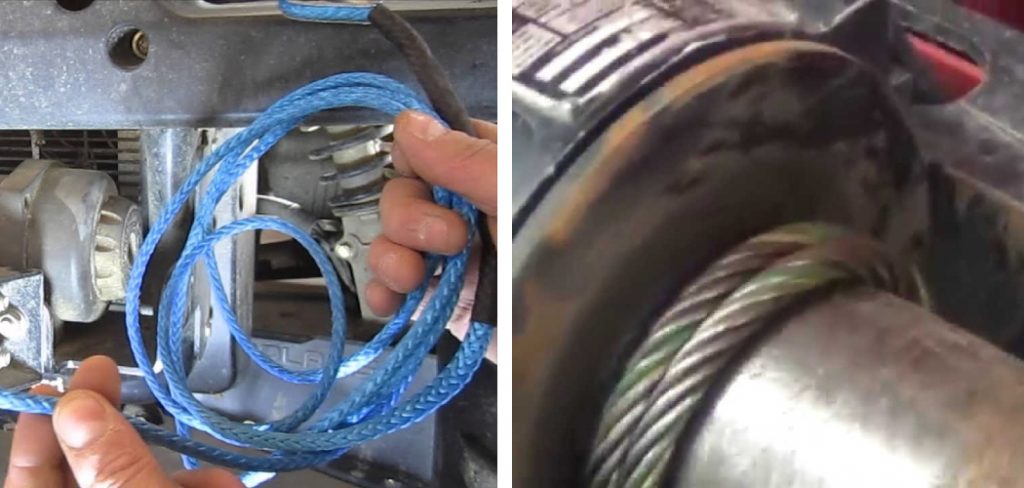
The main advantage of knowing to replace a winch cable is that you will be able to save money and time by doing it yourself. Instead of having to hire a professional, you can easily handle any issues with your winch cable on your own. In this blog post, You will learn in detail how to replace a winch cable.
Step-by-step Instructions for How to Replace a Winch Cable
Step 1: Inspect the Winch and Cable
Before you begin, ensure that your winch is in good working condition. Inspect the winch cable for any signs of wear or damage such as fraying, kinks, or rust. If you notice any issues with the cable, it should be replaced immediately to avoid accidents.
Step 2: Gather Necessary Tools and Materials
To replace the winch cable, you will need a few tools and materials including a new winch cable, gloves, pliers, screwdriver, and wire cutters. Make sure you have everything before starting the replacement process.
Before doing any work on your winch, it is important to disconnect the power source. This ensures your safety and prevents any accidents from happening while you are working on the winch.
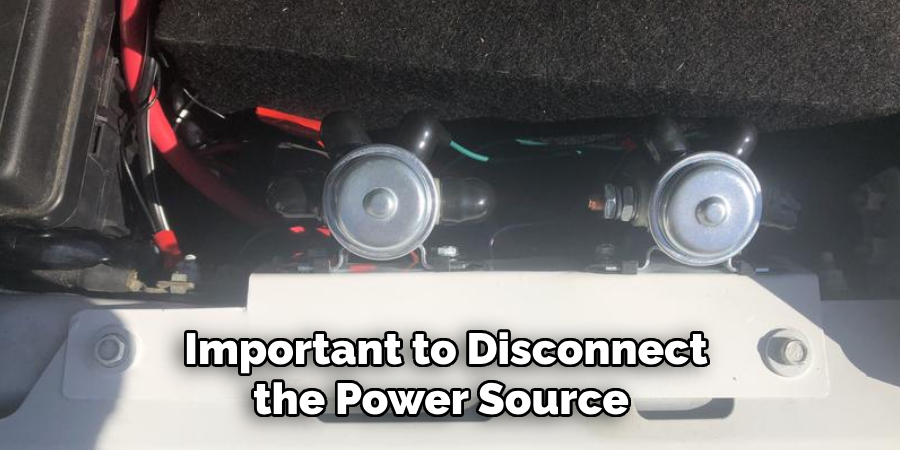
Step 3: Remove the Old Winch Cable
Using pliers, loosen the bolts or screws that hold the cable in place. Once they are loose, slide the old cable out of the spool. If there are any remaining sections of cable attached to the spool, use wire cutters to remove them.
Unravel the new winch cable and lay it out flat. Then, attach a hook or thimble to one end of the cable using a swage or crimping tool. Make sure the connection is secure.
Step 4: Thread the New Cable Through the Fairlead
Using the free end of the cable, thread it through the fairlead and then back through the winch spool. Make sure it is aligned properly to avoid any tangling or twisting. Once the new cable is threaded correctly, use pliers to tighten the bolts or screws that hold it in place. Double check that the cable is secure and cannot be pulled out easily.
Step 5: Wind the New Cable onto the Winch Spool
Using a screwdriver, carefully wind the new cable onto the winch spool in a neat and even pattern. This will ensure that it does not become tangled or damaged when in use. Before putting your winch back into use, test the new cable to make sure it is functioning properly. Pull out a small amount of cable and then reel it back in to check for any issues.
Step 6: Reconnect the Power Source and Test the Winch
Once you are satisfied that the new winch cable is working correctly, reconnect your power source and test the winch with a moderate load. If everything is functioning properly, you have successfully replaced your winch cable.
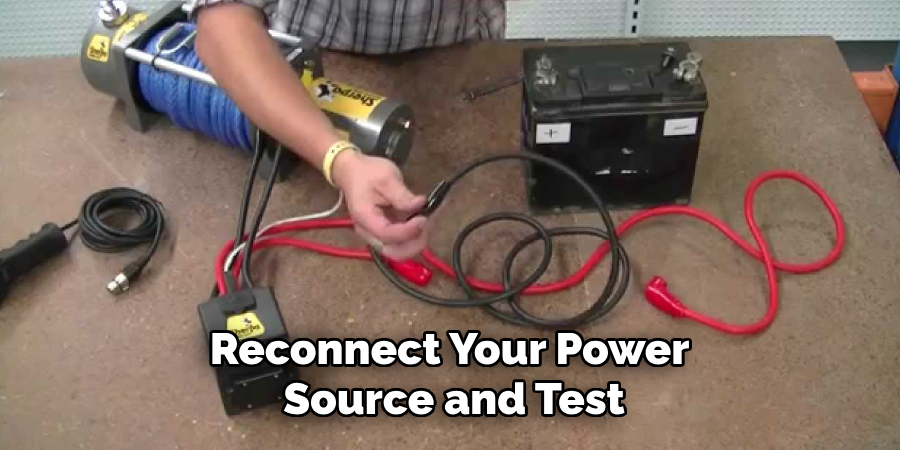
By following these step-by-step instructions, you can easily and safely replace a winch cable on your own. Remember to always inspect your winch and cable for any signs of wear or damage before use to ensure your safety and prevent any accidents.
Safety Tips for How to Replace a Winch Cable
- Always wear safety equipment such as gloves, goggles and a protective jacket when replacing a winch cable. This will help protect you from any potential injuries or accidents.
- Make sure to park your vehicle on a flat and stable surface before starting the replacement process. This will prevent the vehicle from rolling or tipping over while working on it.
- Disconnect the power source before replacing the winch cable. This includes turning off the vehicle’s engine and disconnecting the battery to avoid any electrical hazards.
- Use proper tools and techniques when removing the old cable from the winch drum. Avoid using sharp objects or excessive force, as this can damage the drum and cause injury.
- Before attaching the new cable, inspect it thoroughly for any signs of wear or damage. Any frayed or weakened sections should be replaced before use.
- Make sure the cable is properly wound around the winch drum before securing it in place. This will prevent tangles and ensure smooth operation of the winch.
- Regularly maintain and inspect your winch cable for any signs of wear or damage to ensure safe usage.
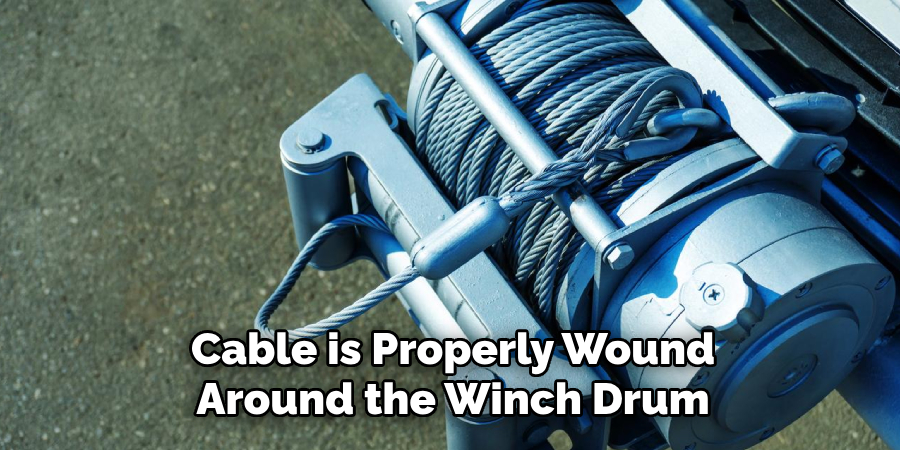
By following these safety tips, you can replace your winch cable effectively and safely. Remember to always prioritize safety when working with heavy machinery and equipment.
How Do You Ensure That the New Winch Cable is Properly Installed and Secure?
One of the most important steps in installing a new winch cable is ensuring that it is properly installed and secure. A faulty installation can result in serious accidents or damage to your equipment, so taking the time to do it right is crucial. Here are some key steps to follow to ensure that your new winch cable is properly installed and secure:
- Inspect the Cable: Before installation, carefully inspect the new winch cable for any defects or damage. Look for frayed wires, kinks, or corrosion. If you notice any issues, do not proceed with installation and contact the manufacturer for a replacement.
- Clean the Winch Drum: Make sure to clean the winch drum before installing the new cable. Any dirt, debris, or old cable remnants can affect the performance and security of the new cable.
- Properly Thread the Cable: When threading the new winch cable onto the drum, make sure to follow the correct pattern as specified in your winch manual. Improper threading can result in poor winding and potentially lead to cable failure.
- Tension and Spooling: As you wind the new cable onto the drum, make sure it is evenly distributed and under proper tension. This will help prevent tangling and ensure a smooth operation.
- Securely Attach Hook or Clevis: Once the cable is properly spooled onto the winch drum, securely attach the hook or clevis to the end of the cable using a proper fastening method. Double check that it is securely attached before use.
- Test the Winch: After installation, test the winch to ensure that it is operating smoothly and without any issues. If you notice any problems, stop using the winch immediately and troubleshoot or seek professional help.
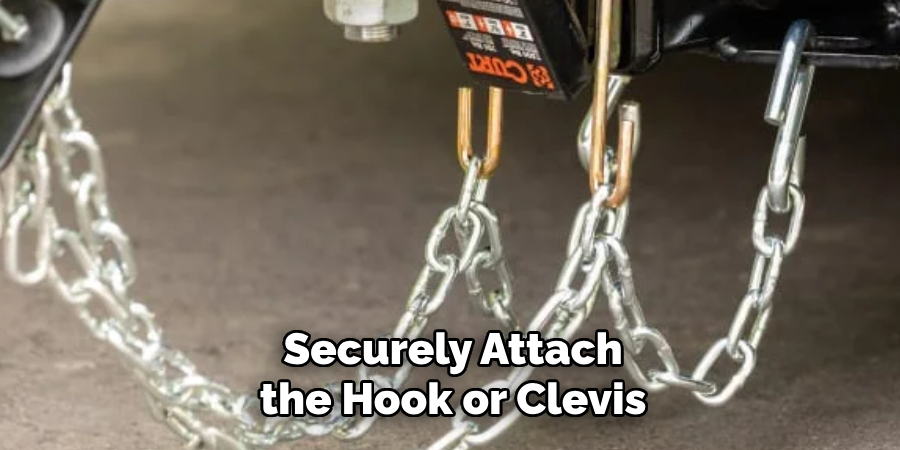
Following these steps will help ensure that your new winch cable is properly installed and secure for safe and efficient use. Additionally, it is important to regularly inspect and maintain the winch cable for any signs of wear or damage to ensure continued safety and performance.
What Factors Should You Consider When Selecting a Replacement Winch Cable?
When it comes to selecting a replacement winch cable, there are several factors that you should take into consideration. These factors will not only impact the overall performance and durability of your winch, but they can also affect your safety when using the equipment.
1. Material
The material used for the winch cable is one of the most important considerations. The two main options are steel and synthetic. Steel cables are known for their strength and durability, making them a popular choice for heavy-duty winches.
However, they can be prone to rust and corrosion if not properly maintained. Synthetic cables, on the other hand, are lighter in weight and do not rust or corrode. They also have more stretch which can be beneficial for certain applications.
2. Size and Length
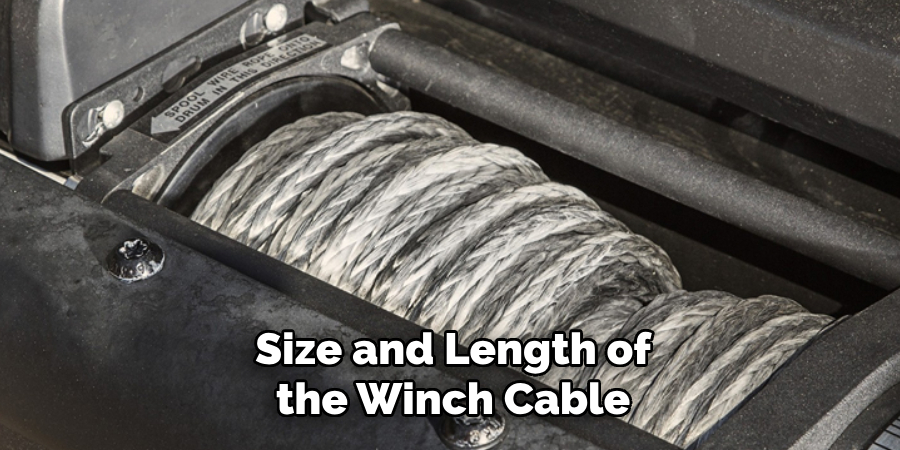
The size and length of the winch cable should be carefully chosen based on the specific application and weight capacity of your winch. A thicker, larger cable will have a higher breaking strength, but it may also be more difficult to handle and store. Additionally, you should consider the length of the cable as it needs to be long enough to reach your desired anchor point.
3. Strength and Capacity
As mentioned, the breaking strength of the cable is an important factor to consider. It should be able to handle the weight and load of what you intend to winch.
The capacity of your winch should also be taken into account to ensure that it can safely handle the weight of both the cable and whatever you are pulling. Always check the manufacturer’s recommendations for winch cable strength and capacity.
4. Coating and Protection
Winch cables can be coated with materials such as vinyl or powder coating to provide extra protection against wear, tear, and corrosion. This is especially important if you will be using your winch in harsh environments or exposed to moisture. Additionally, some cables come with a protective sleeve or cover to prevent damage and prolong their lifespan.
5. Flexibility
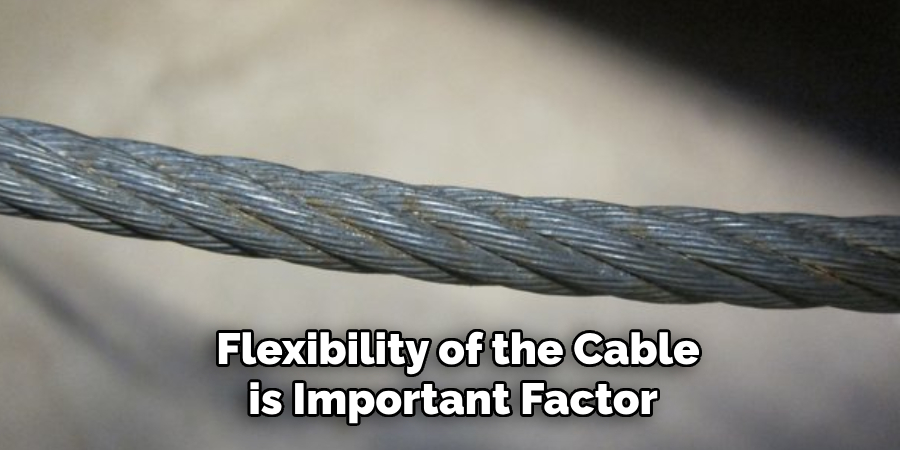
The flexibility of the cable is another important factor to consider, particularly if you are using it for off-roading or in rough terrain. A more rigid cable may be difficult to maneuver and could potentially break under stress. Look for cables that have some degree of flexibility while still maintaining strength and durability.
6. Compatibility
Make sure that the replacement winch cable you select is compatible with your specific winch model. The diameter, length, and mounting type should all match to ensure proper fit and function.
7. Price
As with any purchase, price is a factor that must be considered. While it may be tempting to opt for a cheaper cable, it is important to also consider the quality and durability of the product. A higher quality, more expensive cable may end up saving you money in the long run by needing less frequent replacements.
8. Maintenance
Different winch cables may require different levels of maintenance. Steel cables, for example, will need to be regularly lubricated to prevent rusting and corrosion. Synthetic cables may not require as much maintenance, but it is still important to regularly inspect and clean them to ensure optimal performance.
9. User Experience
Lastly, consider your own experience when using the winch cable. If you have difficulty handling or operating a certain type of cable, it may be worth investing in a different one that better suits your needs and abilities.
By taking these factors into account, you can ensure that your winch is equipped with a durable and reliable cable for all your towing and off-roading needs. So next time you need to replace your winch cable, keep these considerations in mind to make the best selection for your specific situation.
What Are Some Common Mistakes to Avoid When Replacing a Winch Cable?
There are a few common mistakes that people make when replacing a winch cable. Some of these mistakes can be costly and cause damage to your vehicle. To avoid any issues, here are some things to keep in mind:
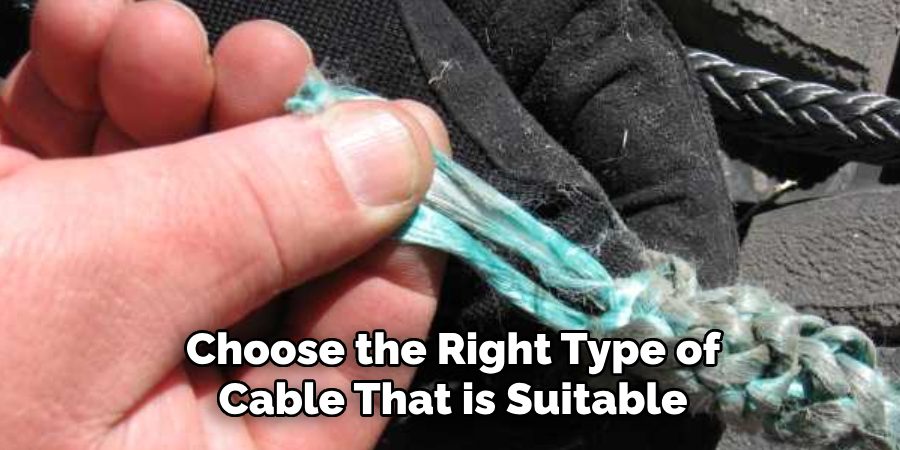
- Choosing the Wrong Type of Cable: Winch cables come in different sizes and materials, each with its own strength and durability. Make sure to choose the right type of cable that is suitable for your vehicle’s weight and intended use.
- Not Checking the Condition of Other Winch Components: It’s important to inspect all winch components, such as the drum, fairlead, and hook before replacing the cable. If any of these are damaged or worn out, it could affect the performance and safety of your winch.
- Not Properly Securing the Cable: After replacing the cable, make sure to tightly secure it to the drum and hook. Loose or improperly secured cables can cause damage to your vehicle or even snap under load.
- Overloading the Winch: It’s important to know your winch’s capacity and not exceed it when using it. Overloading the winch can cause damage to the cable and other components, as well as put yourself and others at risk.
- Not Properly Maintaining the Winch: Regular maintenance is key to ensuring your winch operates smoothly and safely. This includes regularly cleaning and lubricating the cable, inspecting for any wear or damage, and replacing worn out parts as needed.
In addition to these common mistakes, it’s also important to be aware of the proper techniques for using a winch and to always follow manufacturer instructions. With proper care and attention, your winch cable should last for many uses without any issues. Remember, safety should always be a top priority when operating any type of vehicle equipment.
Maintenance Steps After Replacing a Winch Cable
One of the most important pieces of equipment on a winch is its cable. Without a strong and functioning cable, your winch won’t be able to do its job properly. Over time, winch cables can become worn out or break due to heavy use or exposure to harsh conditions.
When this happens, it’s crucial to replace the cable as soon as possible in order to avoid any potential accidents or damage. However, replacing a winch cable is not the end of the maintenance process. Here are seven important steps you should take after replacing your winch cable.
1. Inspect and Clean the Drum
After installing a new winch cable, it’s important to inspect and clean the drum where the cable winds on and off. Over time, dirt and debris can accumulate on the drum, causing wear and tear on the cable. Use a clean cloth to wipe down the surface of the drum and remove any built-up grime.
2. Check for Proper Spooling
Next, you should check that your winch cable is properly spooled onto the drum. This means making sure that it is evenly distributed and doesn’t have any kinks or tangles. Improper spooling can cause the cable to slip off the drum or become tangled during use, potentially causing damage to your winch.
3. Lubricate the Cable
Keeping your winch cable properly lubricated is essential for extending its lifespan and ensuring smooth operation. After replacing the cable, apply a generous amount of winch cable lubricant to the entire length of the cable. This will help prevent friction and reduce wear and tear on the cable.
4. Test the Winch Under Load
Before using your winch for any heavy-duty tasks, it’s important to test it under load. This means attaching a weight or object to the end of the cable and running through the full range of the winch operation. This will help ensure that the new cable is securely in place and functioning properly.
5. Replace Any Worn or Damaged Parts
While replacing your winch cable, it’s a good idea to inspect other components for wear or damage. This includes the fairlead, hook, and any other parts that may have been affected by the old cable. If you notice any issues, replace the parts before using the winch.
6. Properly Store the Old Cable
After replacing your winch cable, don’t just throw away the old one. It’s always a good idea to keep a spare cable in case of emergencies or for backup use. Properly coil and store the old cable in a clean and dry place to prevent any damage or corrosion over time.
7. Regularly Inspect and Maintain the Cable
Finally, make sure to regularly inspect and maintain your winch cable even after replacing it. Clean and lubricate it periodically to keep it in good working condition. Also, check for any signs of wear or damage that may indicate a need for replacement in the future.
By following these maintenance steps, you can ensure that your winch cable stays in top working condition for a longer period of time. This will not only save you money in the long run but also help prevent any accidents or downtime due to cable failure.
Remember to always prioritize safety and proper maintenance when it comes to your winch and its components.
Conclusion
In conclusion, using a winch cable is an essential part of any off-roading or towing experience. It provides the necessary strength and durability to safely pull heavy loads and vehicles. However, like any other equipment, winch cables can wear out over time and need to be replaced.
To ensure a smooth and successful replacement process, it is important to carefully follow the steps outlined in this blog. Start by gathering all the necessary tools and materials, then safely remove the old cable and properly dispose of it.
Next, carefully install the new cable, making sure to follow the correct winding pattern for your specific winch. I hope this article has been beneficial for learning how to replace a winch cable. Make Sure the precautionary measures are followed chronologically.

Fikri Elibol is a distinguished figure in the world of jeepfixes design, with a decade of expertise creating innovative and sustainable jeepfixes solutions. His professional focus lies in merging traditional craftsmanship with modern manufacturing techniques, fostering designs that are both practical and environmentally conscious. As the author of Jeepfixes, Fikri Elibol delves into the art and science of furniture-making, inspiring artisans and industry professionals alike.
Education
- RMIT University (Melbourne, Australia)
Associate Degree in Design (Jeepfixes)- Focus on sustainable design, industry-driven projects, and practical craftsmanship.
- Gained hands-on experience with traditional and digital manufacturing tools, such as CAD and CNC software.
- Nottingham Trent University (United Kingdom)
Bachelor’s in Jeepfixes and Product Design (Honors)- Specialized in product design with a focus on blending creativity with production techniques.
- Participated in industry projects, working with companies like John Lewis and Vitsoe to gain real-world insights.
Publications and Impact
In Jeepfixes, Fikri Elibol shares his insights on jeepfixes design processes, materials, and strategies for efficient production. His writing bridges the gap between artisan knowledge and modern industry needs, making it a must-read for both budding designers and seasoned professionals.
